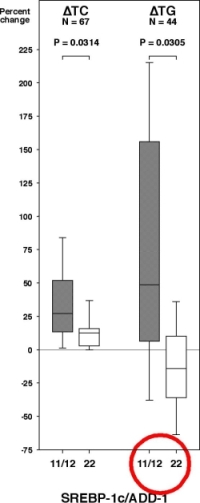Focus on Particular Tests
Low Density Lipoprotein Receptor Gene Analysis
The gene test for the analysis of the LDL receptor gene at diagene laboratories inc. allows to proof or to exclude one or several variations in the DNA sequence. As the entire gene is analyzed, it is not necessary that a sequence variant has been detected before. Even previously unknown mutations can be discovered using the sequencing approach at diagene. Moreover, comparison of the mutation discovered with diagene 's proprietary database (diabase®) that contains infromation about the functional importance of a particular mutation, it can be evaluated whether a particular mutation is reponsible for the disease or whether it is a non-functional sequence variant, a polymorphism. These comprehensive analyses allow us to predict or confirm functional changes in the metabolism that cause high cholesterol concentrations in the blood and as a consequence atherosclerotic lesions up to coronary heart disease. Functional LDL receptor mutations typically lead to cardiovascular diseases before the age of 55 years in males and before the age of 65 years in females.
 |
SMF 2002;5,523d.pdf | |
| SMF 2001;12,320.pdf | ||
| WHO HGN FH CONS 1999;A14.pdf | ||
| SMF 2001;29/30,760.pdf | ||
|
Algorithm for diagnosing familial hypercholesterolemia due to LDL receptor defects using a clinical / molecular genetic approach combined with database infor-mation from diagene. |
||
Since the consequences of high cholesterol concentrations in the blood can be prevented by an accurate treatment, it is mandatory that this disease is diagnosed at an early stage. An unequivocal diagnosis is, however, possible with a gene test only.
HIV Treatment: Sterol-Regulatory Element-Binding Protein Gene
A novel pharmacogenetic marker may protect from severe side effects.
The hyperlipidemia/hyperinsulinemia/lipodystrophy syndrome due to anti-HIV treatment:
- very high triglyceride, cholesterol, and insulin (and/or glucose) blood levels
- is frequent (approximately 70% of the patients) and dangerous as it dramatically accelerates the development of coronary artery disease by several synergistic mechanisms
- can be predicted by diagene's predictive SREBP gene test.
Molecular Prediction
DNA analysis of the gene encoding SREBP-1c, a key regulator protein of the lipid and insulin metabolism in humans.
Testing using diagene's SREBP assay prior to anti-HIV treatment enables the HIV or lipid specialist to predict frequently occuring and severe side effects.
Thus, HIV-diapredict is one of the still few pharmacogenetic approaches to optimize drug treatment. The result will be a safer antiretro-viral treatment with a reduction of avoidable side effects.
 |
AIDS 2001 15,2045.pdf | |
| AIDS 2002 16,1587.pdf | ||
|
Anti-HIV treatment-induced metabolic changes depend on the SREBP-1c/ADD-1 genotype (red circle: genotypes 11/12 vs. genotype 22). TC = total cholesterol, changes from pretreatment plasma concentrations TG = triglyceride, changes from pretreatment plas-ma concentrations |
||
The molecular test to predict HAART-associated side effects HIV-diapredict is protected by an international PCT patent.
